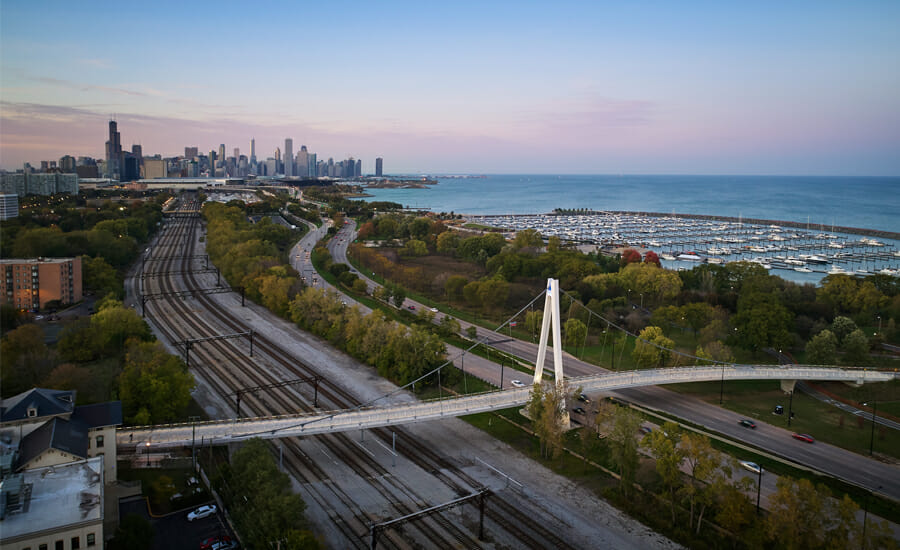A bridge is never just a bridge. It symbolizes a pathway, accessibility, and a connection between two distant places connecting people, places, communities and culture.
As a senior civil engineer, I have worked on many bridges throughout my career, but when I was assigned to work on the 35th Street Pedestrian Bridge, I realized that this bridge project was the opportunity to forge a partnership between the Bronzeville community and the Chicago lakefront, a relationship that had long been neglected. This strategically designed bridge was also meant to forge another important relationship; with the natural environment in which it would be encompassed.
The project began in 2004 when EXP competed and won the Bridging the Drive competition hosted by the City of Chicago and the Chicago Architecture Foundation, a contest designed to involve the local community in the selection of concept bridge designs. As residents near the 35th Street Pedestrian Bridge are separated from Lake Michigan, the lakefront bike trail and other recreational opportunities in Burnham Park by six rail lines carrying frequent commuter and freight trains and by South Lake Shore Drive, the bridge meets the critical need of providing access between the Bronzeville community and the lakefront.
The previous bridge, built in 1933, was rapidly deteriorating and was not compliant with the Americans with Disability Act (ADA).
The declining condition, outdated and unattractive design, staircases on both ends, and poor lighting made it unappealing for cyclists and pedestrians, thereby discouraging the community from accessing the Chicago lakefront, and lakefront users from accessing attractions in the Bronzeville community, including the Stephen A. Douglas Tomb and Memorial at the west end of the bridge. Today, 35th Street Pedestrian Bridge is a mono-cable, self-anchoring suspension bridge that crosses Lake Shore Drive at 620-feet long, it is Chicago’s longest pedestrian bridge. While the bridge design, itself, exhibits power, strength and balance, it also represents the power to bridge the community back together with essential features in the area, the lake and the environment.
As a project team, we were committed to accomplishing two specific goals for 35th Street Pedestrian Bridge. The first was to restore the relationship between the community and the lake and the second was to establish a connection between the bridge and its surrounding local environment.
The progression of bringing these goals into reality required extensive collaboration with our client and with our own team of experts.
One of the ways we met the project’s goal of restoring the partnership between the community and the lakefront was to design the bridge to be ADA-accessible by replacing the stairs with ramps, to ensure bicyclists, pedestrians and the entire community could access and enjoy the bridge.
To meet the second goal, our team recognized the need for both ends of the bridge to be compatible with the adjacent environment. At the west bridge landing are two important destinations: the Stephen A. Douglas Tomb and Memorial operated by the Illinois Historical Preservation Agency (IHPA), and the Cardinal Meyer Center which houses the headquarters for the Archdiocese of Chicago. The project team coordinated with the IHPA to ensure the design complimented the existing fencing surrounding the tomb’s site. In coordination with the alderman, new Gateway 2000 lighting (poles designed to provide illumination over large areas of the right-of-way as effectively as possible) from the city of Chicago lighting palette was provided along 35th Street and South Lake Park Avenue. On the east end of the bridge, the project team coordinated with the Chicago Park District to connect the bridge with the Lakefront Trail and to provide a look-out at the end of the bridge to sit and relax. These design elements uniquely tied the bridge in with the adjacent environment, all while meeting the needs and desires of the community.
From inception to completion, 35th Street Pedestrian Bridge challenged the traditional idea of coming together. With this bridge, the Bronzeville community and the lakefront were finally united and historical landmarks and new opportunities merged. As a newly formed civil icon for the city of Chicago, 35th Street Pedestrian Bridge not only provides an iconic and striking bridge for motorists on Lake Shore Drive to enjoy, but it also gives back to the community and the environment by providing an anchor of hope for what’s to come.
Douglas Hansen, PE | Project Civil Engineer | Chicago, IL
*Originally published in EXP’s Expresso: Convergence

